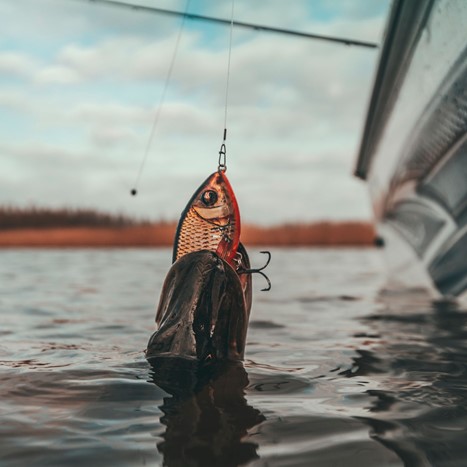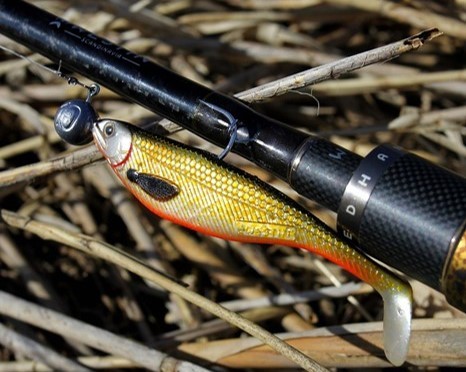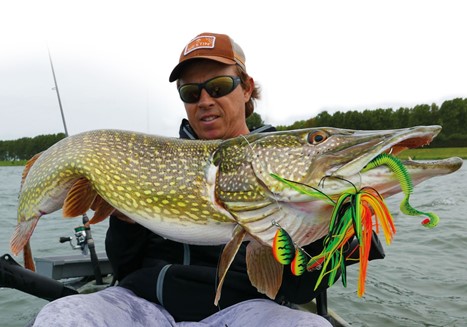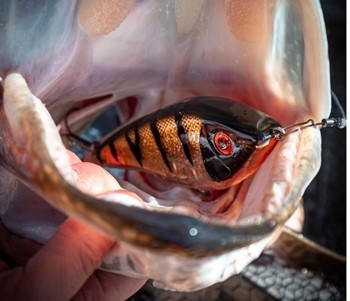PIKE FISHING TIPS AND TECHNIQUES
Written by: Thom Hunt
In this article I’d like to discuss the intricacies of the pike, and how learning the principles below can improve your catch rate.
Over the years I’ve found patterns and learned lessons on everything from where they're likely to be found at any given season of the year, through to water temperatures, weather conditions and even the size of teethmarks in your lure can affect how I select certain baits or fish specific presentations. Each year for the last 5 years I’ve set myself (and achieved) the target of catching 100 lure caught pike per season/year.
Last year I managed 121 from 17 different venues including rivers, canals, reservoirs and gravel pits both in the UK and abroad. I say that not to boast (and there may well be anglers out there who catch many more than that) but to iterate that after consistently catching good numbers of fish, I’d have to be an idiot not to spot specific patterns that repeat themselves year after year. And if you focus on and learn these patterns you will definitely catch more pike.
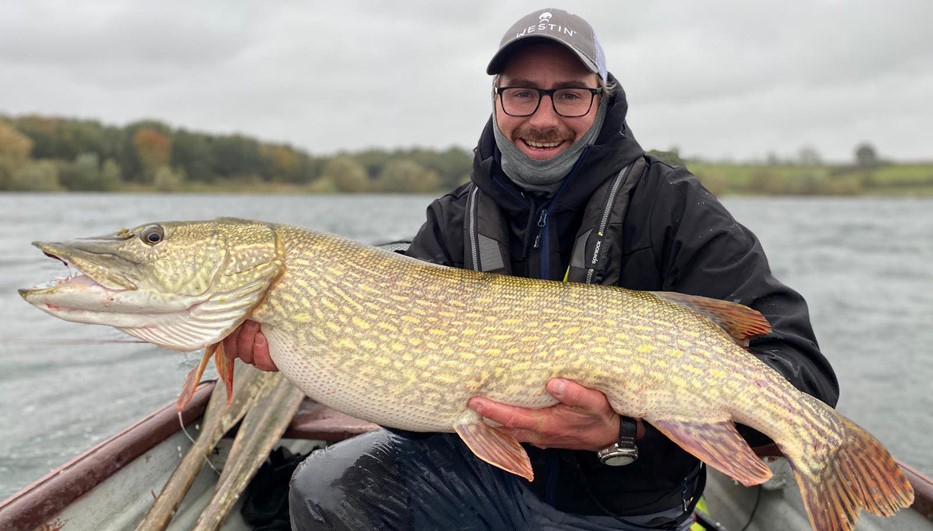
A biology lesson…
So lets start with a little bit of biology, and the general rules I stick to through out the year. The reason I have started with biology, and then later discuss the annual ecology cycle of pike in depth, is because a large part of consistently catching pike is in the old adage of location, location, location. So whether its a large river, reservoir or lake you are targeting, knowing what to look for at what time of year will hugely cut down your failure rate. Pike are aggressive and tend to bunch up in certain areas of a waterway, so can be relatively easy to catch. Whats not relatively easy to do is find them.
Pike excel as the top underwater apex predator in most freshwater systems. They have many senses that they utilise for hunting but the most important one, without doubt, is SIGHT.
How do we know this? Because by simple deduction, when a waterway has a consistent amount of suspended particulate (muddy/murky/low visibility) pike will generally NOT be present in large numbers. This is a really important point to consider, and one we’ll come back to later…. when you think of a lure approach for pike, don't first think taste or smell, don't think sound, think SIGHT.
Of the three main predators in the UK (pike, perch & zander) we also know that pike grow to the largest sizes, in relative terms have the largest mouth and also in relative terms have the largest teeth. Not surprisingly then, their ‘personality’ as such tends to be dominant, aggressive and generally lacking caution, and we can take advantage of this as anglers, by creating an approach that can match this.
Ecology cycle of pike…
We also need to consider the time of year. The general cycle for a pike goes as follows. When the water is warm (anything above 14 or 15 degrees), pike will be spread out and moving up and down in the water column and exploring shallow to mid depth often weedy areas looking to ambush bait fish that are also well spread out at that time of year.
As the temperatures cool in the Autumn (up to roughly Christmas) pike will start to feed heavily and bait fish shoals will naturally concentrate as they are predated upon. The more temperatures drop the more both pike and baitfish will congregate in deeper, more stable (in temperature and oxygen terms) water that is less prone to being affected by the vast changes in the weather seen in the winter (frosts, storms, heavy rainfall)
In winter, shallow water is the first to cool down, but also the first to warm up so once the water temp is down to the 3-6 degrees mark, the absolute best areas to look for will be steep underwater drop offs at the northern bank of a lake, river or canal. Why the Northern bank? Well, its generally the most protected area from cold Northerly (or North easterly) winds which come from Siberia, it benefits from warm South Westerly winds (coming from the Caribbean) and is South facing so gets maximum sunlight so therefore warmth, at the cold time of the year. All in all, most Northern banks of a fishery will be a degree or two warmer, and in the depths of winter, for a cold blooded animal (meaning it temperature is the same as the water around them) this can make a huge difference.
The steep drop offs are excellent, especially in the new year, as pike can sit in deep stable water overnight, then if a warm, sunny January day arrives and the shallow water warms quickest, the pike will seek that warmer water, and the shortest distance from deep to shallow will be a steep underwater drop off.
In a large lake for example, its a much shorter distance to migrate 30-50ft up a shelf to find warmer shallow water, than it is to swim 300ft to the back to a gently sloping long bay.
Coming in to the spring, usually in February or March, as temps rise and specifically hit between 6 & 7 degrees, this triggers movement towards the shallows (often reed lined bays) in preparation for spawning. This is when pike can be caught at their heaviest weight, often much shallower than you imagine for still very cold conditions, as they have their last pre-spawn feeding spells.
However, once they start spawning this is the time to leave them alone, not only to let them get on with spawning, but they also tend to be very difficult to catch so its largely a waste of time. It really is a sight to see though, if you have a water nearby with good water clarity, it’s possible to sometimes watch 2-5 males ‘courting’ a large female. It’s almost like a choreographed dance where they weave in and out of each other in a bid to impress and mate with the female.
From March in to April, this is what I would class as the worst possible time of year to target pike. During and after they have spawned they go into what American anglers call ‘the post-spawn funk’. They tend to be very moody, often in very poor body condition from spawning stresses, and generally not feeding properly, swiping at baits and hook up ratios can be very poor.
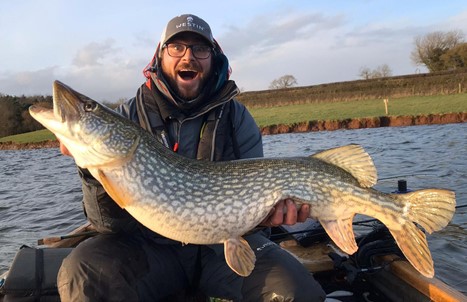
However, what follows is what I consider to be the very best time to target pike…. The post spawn feed up! It is a period that can be insanely intense, often lasts at its peak for around 2 weeks or so, and is very often the last 2 weeks in May.
And let me tell you, the fishing can be absolutely insane. At this time of year the water temp is usually up to about 10/12 degrees and they hit the lures really hard, really aggressively and in big numbers. I tend to not fish specifically for pike much from July to September, partly as the water temps are up but also partly as I target other species like Perch and Chub.
Then when the ‘pike season’ starts again, I use an old adage I learned from fishing in Denmark… When the water hits 11 degrees the pike are worth catching. Its not that you can’t, or shouldn’t fish for them before this, but they just wont be fat enough yet, not for the Danish anyway, they hate catching skinny pike!
So to recap quickly, heres a quick summary of what to consider and where to concentrate your efforts
|
|
Summer |
Autumn |
Winter |
Spring |
|
Water Temp |
15+ |
13 down to 8 |
7 down to 3 then up to 7 |
8 up to 13 |
|
Areas to concentrate |
Large, shallow to mid depth flat areas that receive wind |
Begin looking for transitions towards deeper, more stable water holding baitfish |
Deep areas with steep underwater shelves then once up to 7 look for pathways to adjacent shallow spawning bays |
Secondary points/first bit of deeper water coming out of spawning bays |
|
Notes |
Spread out, difficult to locate numbers,often aggressive reaction strikes, long slim fish |
Superb time of year for numbers and good size. Will be fat once water hits 11 degrees |
Short intense heavy feeding periods (usually first and last light) mixed with large spells of almost zero activity. Pike at their largest |
March/April - Avoid May - Post spawn feed can be one of the best times for pike fishing. |
Fishing Techniques
So on to the fishing techniques for pike..... of all the predatory species we have here in the UK, the pike is definitely the most aggressive. Of course there are days when they are tricky, following lures rather than taking them, coming up short on the lure etc, but most of the time if other predators are tricky to catch, I’d still put money on myself to catch a pike.
For this reason my go-to will always be to begin fishing very positive. By positive I mean fishing larger sized aggressive action lures, fished a medium-fast pace, fishing midwater (a fair way off the bottom), and other than occasional pauses to induce takes, I tend to fish a constant wind retrieve. There are other presentations that catch well, and I discuss them below, but my banker method will always be a positive presentation.
There are 4 main types of lure I use for targeting pike and each has their own set of circumstances. These 4 types are:
- Soft Plastics - Aggressive
- Soft plastics - Subtle
- Spinner baits
- Swimbaits/crankbaits/jerkbaits
1. Soft baits (aggressive)
By aggressive soft plastics I mean the type of shads that have large paddle tails, thick wrists to the tail and most importantly a BODY ROLL action. Body roll is when the tail and the body/belly of the lure simultaneously twist in opposite directions. Without doubt it is the type of soft plastic that creates both the most amount of vibration/turbulence in the water, but more importantly is visually the most eye catching as the belly and tail are constantly ‘flashing’ back and forth. And if you remember back to what I said about a) pike using SIGHT as their primary feeding sense and b) their naturally aggressive ‘personality’, a lure that can be seen easiest will often be a lure that gets hit most often.
Over the last 12-18 months I’ve been predominantly using the Westin Shadteez, in 12cm, 16cm and 19cm sizes and hand-on-heart I really have to say it is a very, very special lure. I know many people may be thinking ‘well of course he would say that he’s sponsored by Westin’ but I class myself first and foremost as a tournament angler, and I pride myself heavily on doing well, so for me, I have to use what I genuinely believe is going to catch more than those around me, and without question that is now the Shadteez when it comes to pike.
There are many circumstances however that an aggressive soft plastic will not be the best option, so in that case I look for soft plastics with a more subtle action….
ShadTeez - a great example of what I consider an aggressive soft bait
2. Soft baits (subtle)
Subtle action soft plastics, for me, are generally slimmer lures with smaller paddle tails or curly tails, and specifically lures with NO body roll. If I do select a lure with body roll I will select a much smaller size, usually 10cm or 12cm, and any time I’m fishing a bit more negatively, couple it with a much slower retrieve rate. Deep, small, negative and slow is a good mantra when the fishing is tough!
Look for shads where the ‘paddle’ on a paddle tail looks like a thin disk of plastic stuck on the end of a thin tail wrist. They tend to have a quick vibration rate but don't disturb huge amounts of water or send off heavy signals/vibrations. A superb example in the Westin range is the Hypoteez.
The 3 main circumstances I will select subtle lures are the following.
- VERY clear water - having visibility of more than 5ft can often make the fish wary/cagey (especially if theres little to no wind) so aggressive plastics can simply be ‘too much’ but a subtle lure can produce a response.
- VERY cold water - When the water dips below 6 degrees, pike will become lethargic for many hours of the day. Those cold, crisp high pressure periods will usually produce feeding activity at first light and last light, however the middle of the day can be slow as the pike just sit there, often hard on the bottom, often only just moving a fin here or there to stabilise themselves, digesting their morning feed. The biggest indicator of this will be the presence of leeches on the body. I’ve caught fish this winter with they as many as 30 leeches on the body. have a think about how long a pike has to sit motionless on the bottom for 30 leeches to attach on the body. Its clear then that they're not always in an aggressive/active mood. If you stick to aggressive lures, generally you have to wait until the afternoon again to get a bite, when they come back ‘online’. But especially in tournament situations, a switch to a smaller lure, or a more negative lure can spark a reaction.
- HEAVY FISHING PRESSURE - In the UK we have a famous venue called ‘Chew Valley’, a large lake that has produced hundreds of 15-20kg+ pike. However, unless you get a ticket to fish in the first week of the season, the sheer volume of boats, baits and bank anglers can make the pike tricky to catch to say the least. Just do the maths. 25 boats a day. Thats 50 anglers. thats often 100 rods PER DAY. Do that for a week or 2 and its no wonder the fishing gets hard. There are rare days when the conditions are perfect and good numbers of fish will feed, but my top tip is to down size your lure and fish much more negatively. Ive caught more 10kg+ pike from Chew on a 10 or 12cm bait than any other size. The opposite of this would be lakes in Scandinavia for example. Huge expanses of wild water with very little pressure. Over there, they rarely consider using baits less than 8”, but for our heavy pressured waters smaller baits DEFINITELY produce more fish.
3. Spinnerbaits
There are only 2 reasons I will ever tie on a spinner bait. the first is water temperature….. it needs to be a minimum of 13/14 degrees.
When the waters warm I fish them fast, often as fast as you can wind them. If theres any clarity to the water you HAVE to fish them fast as they look so unnatural if you give the pike any chance to inspect the bait they will just follow or swipe at the bait. Fish them fast and they have no choice but to attack it positively. For this style of fishing look for spinner baits with long slim ‘Willow leaf’ blades and natural colours so think white, silver, blue etc.
The second is muddy/low visibility water. In these conditions select spinner baits with larger, wider ‘Colorado’ blades and much brighter colours like chartreuse, or pink. Colorado blades ‘thump’ and produce much heavier vibrations which allows the pike to find the bait when their eyesight is reduced due to the coloured water.
A 119 cm pike that absolutely smashed the Monstervibe Colorada
4. Swimbaits/Crankbaits/Jerkbaits
These can be superb all round baits, they can be good in warm or cold water, but the number one advantage for these baits is their ability to suspend when paused. and on certain days this can be an absolute killer technique, which can see you double or triple the catch rate of others around you if you can get the presentation correct. A classic example for me would be in the spring, the water temp is rising but still very much on the chilly side, and the pike are starting to come out of their deeper winter haunts and look for food in shallow areas, especially as weed growth starts to appear and the first warm, sunny days can warm the shallows.
In this instance, having a bait with a bit of aggression or vibration (which these baits have) can be great, but the pike are still cold and may not be fully prepared to chase a bait, so twitch, twitch PAUSE can be a devastating presentation. If most of your hits come on the pause, that is the indication its the correct way to fish for those conditions, and those are the circumstances that will definitely out fish say a soft plastic shad fished on a straight retrieve.
One lure to mention here is the Westin Swim. This is probably one of the most versatile lures out there - it simply works in almost any condition or type of water, and is really easy to use at the same time.
To finish off I’ll just run through a couple of my thoughts on rod, reel and braid set ups. For most of my fishing with perch or zander I like fast action rods for hitting bites quickly, however with pike I prefer slower, through action rods for a number of reasons.
Firstly I fish for perch and zander with a lot more twitches and pauses and they tend to hit the lure when it is falling after a pause. This gives them a little bit more slack in the line so a fast rod helps hit bites and pick up the slack. However, with the majority of my pike fishing I'm looking to fish quicker, more direct and I get many hits directly as I'm retrieving the lure, so I prefer a slower, through action rod to actually give a split second extra on the bite so I DONT hit the bite immediately. Also, when using bigger lures, with larger treble hooks and you consider the shape of a pikes long snout, coupled with a bite when you're directly winding, means a slower action rod gives that extra bit of time for the bait to get fully inside the pikes mouth to get a decent hook hold. Theres a lot of hard teeth, hard bone and jaw at the front of the mouth thats difficult to get a hook hold. Theres many more places a good hook hold can be achieved anywhere from the scissors or further inside the mouth so let that bait go deeper in the mouth before striking!
My river set up is based almost exclusively around that fact there are so many snags in rivers. you need to both retrieve snagged lures (or it gets expensive) and sometimes bully hard fighting wild pike away from snags so ‘proper’ kit is required. Strong rods, 65lb+ braid, 50-80lb wire and this is the main point… refit all your trebles with 30lb split rings to the lure. I have never lost a fish on this strength split ring, but if you hit a snag, with the braid and wire combo you can wind down and give it a straight pull and you'll get your lure back, minus the trebles of course!
My reservoir set up is different though. For anything up to 6” shads and most 4”-6” hard baits a rod rated 30-80g or 40-100g will be adequate. My preference is 8’ or 8’6” long but the main change will be the braid, I scale way down on the braid to achieve much longer casts. I usually go for around the 10-12kg mark and this is a great balance for me between strength and diameter. On big reservoirs with a balanced set up I’m looking to cover as much water as possible and like to be casting 40-60 yards on every throw. This can also really help on pressured waters you'll get a lot more takes further away from the boat.
Other important tips for the pike:
- Be very, very aware of where in the mouth you are hooking pike on any given day. because pike have the longest ‘snout’ of all the predatory fish, this is one of the biggest giveaways as to how confidently they are feeding, and then how to adjust you baits or retrieve to coincide with that. Pike hooked on the front of the mouth are ‘negative’ so smaller baits fished slower will be best. Pike hooked deeper in the mouth are aggressive, so larger baits fished quicker will be best.
- If you can, always start your day on a new lure. Putting on a fresh soft plastic for example is the easiest way to tell if you've had a ‘contact’. Occasionally, and I'm sure we’ve all experienced this, you get an unusual felling on the line. Did you hit a baitfish? Was it a gentle pike bite? Did you hit some weed or a small branch?The easiest way to tell will be inspect your lure for bite marks on your brand new lure. If you use a lure that is old, or already has marks on it, any new marks will be indistinguishable.
- The Wire vs Flurocarbon debate. Personally I’m not a fan of heavy fluorocarbon purely down to its thickness and therefore how it affects presentation. I can see an argument when fishing shallow that the thick line keeps the lure up high but for me, I prefer wire most of the time. People say the advantage to fluorocarbon is that its invisible…. well for other species i think this brings an advantage, but for pike I’m not sure it matters too much. most of my logic is based around the visuals again and goes something like this…… so you're telling me the pike can see the 0.4mm wire on the trace, but missed the heavy gauge size 2 trebles on the bait? As far as I know, if you do go for a fluorocarbon trace, make sure you go by diameter NOT by breaking strain. 1-1.2mm thick is a good place to start. Heavy Flurocarbon is used almost exclusively in Europe but here in the UK it hasn’t seemed to gain many followers.
- Always check your hooks after catching fish or hitting a snag. Pike have insanely bony mouths you've got to have razor sharp hooks to maximise you're fishing. Have a file or sharpening stone ready to put a point back on a hook if its lost its edge.
- Find the right depth zone. whether you're on a canal, river or reservoir, keep an eye on the depth you catch fish in, and I don't just mean ‘shallow’ or ‘deep’.By counting your lure down (or keeping an eye on your fish finder) you can work out the TOTAL depth of water you're fishing in but also pay attention to where you are getting hit in the water column. Have you only put three turns on the reel after your lure hit the bottom and you've had 2 bites like that today and they're coming up with leeches on them? That means they're deep/near the bottom. Alternatively, getting bites whenever you get near the edges or a weed bed and you see the pike come out of no where and hit the lure under your feet? Then they're shallow and active so fish accordingly. This is one of my winning tournament strategies. Last year for example I fished a comp at Chew Valley, I found an area full of pike that was about 3.5m deep and had 1m of weed on the bottom. As we drifted shallower there was more weed coming nearly up to the surface and it just wasn't right. However, once we exhausted the first area, using my experience of the lake we went off to find the same profile, 3.5m deep with 1m of weed on the bottom and bang, into pike straight away again, and I went on to win the Tournament. They just seemed to be liking that kind of depth profile so keep an eye of your water craft and you can often use that to find other productive areas.
- Dealing with followers… This can be really frustrating, as some days it seems all the pike want to do is follow your lure but you cant seem to induce a take. Well heres my rule of thumb that will sort out most of that…. If the water temp is below 10 degrees Celsius and you get follows SLOW YOUR LURE DOWN. If the water temp is above 10 degrees SPEED YOUR LURE UP. In cold water, if they're not attacking a lure its probably because they're lethargic, so slow everything down and flutter your lure as much as possible, leaving it ‘on the hang’ away from the boat or bank to induce a take away from you as if they follow all the way to the end of your retrieve, chances are they'll see you and abort rapidly.
In warmer water, especially if the water is clear, you may be giving them too long to inspect the lure. Speed it up and try for a reaction strike and usually they will snap at a lure fished aggressively if they've been following a lot.

